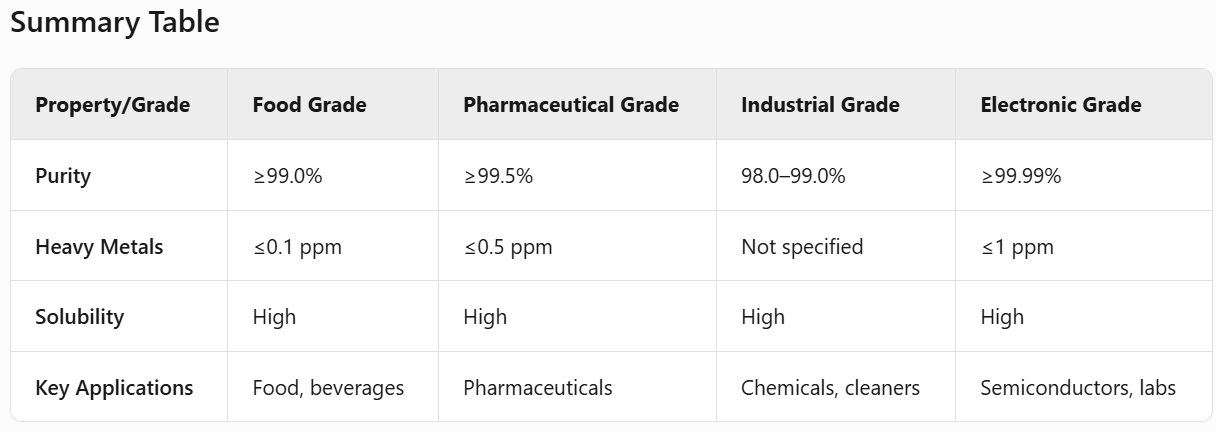Citric Acid
 The address of our Hong Kong Office: 1Queen's Road Central, Hong Kong
The address of our Hong Kong Office: 1Queen's Road Central, Hong Kong Send me a request
Send me a request
Product Details & Description
Product Info
Chemical Identifiers
Product Info
Customers, we are the exclusive agent of Chinese raw material processing factories. We can directly provide you with food grade citric acid (purity range: ≥99.0%), pharmaceutical grade citric acid (purity range: ≥99.5%, some up to 99.9%), industrial grade citric acid (purity range: 98.0%~99.0%), electronic grade/high purity citric acid (purity range: ≥99.99%), special forms and composite products (citric acid monohydrate, anhydrous citric acid, etc.). The more you purchase, the lower the unit price you will get. If you need to purchase citric acid, please leave a message and contact me!

1. Food Grade Citric Acid
Chemical Properties:
Molecular Formula: C₆H₈O₇
Molecular Weight: 192.12 g/mol
Appearance: White crystalline powder or granular solid
Solubility: Highly soluble in water (e.g., 59.2 g/100 mL at 20°C) and ethanol
pH (1% solution): ~2.2–2.5 (strongly acidic)
CAS Number: [5949-29-1] (anhydrous); [5785-94-3] (monohydrate)
Purity: ≥99.0% (typically 99.5–99.9%)
Physical Properties:
Odor: Odorless
Density: ~1.66 g/cm³ (anhydrous)
Hygroscopicity: Slightly hygroscopic
Applications:
Food Industry: Acidulant in beverages (sodas, juices), candies, and dairy products (yogurt, cheese).
Preservative: Inhibits microbial growth in canned foods and sauces.
Flavor Enhancer: Adds tartness to baked goods (cakes, bread).
Regulatory Compliance: Must meet FDA, FCC, and EU food safety standards (e.g., heavy metals ≤0.1 ppm).
2. Pharmaceutical Grade Citric Acid
Chemical Properties:
Identical to food grade in molecular structure.
Purity: ≥99.5% (often 99.7–99.9%)
Heavy Metals: ≤0.5 ppm (lead, arsenic) per USP-NF standards.
Microbial Limits: Absence of pathogenic bacteria (e.g., E. coli, Salmonella).
Physical Properties:
Sterile-grade variants may undergo additional processing (e.g., gamma irradiation).
Applications:
Drug Formulations:
Tablets/Capsules: Excipient for binding and pH adjustment.
Injections: Anticoagulant in blood transfusions and dialysis solutions.
Medical Disinfectants: Used in catheter flush solutions and wound cleansers.
Chelating Agent: Binds metal ions in pharmaceuticals (e.g., iron overload treatment).
3. Industrial Grade Citric Acid
Chemical Properties:
Purity: 98.0–99.0%
Impurities: Higher tolerance for residual salts (e.g., sodium citrate ≤1%).
CAS Number: Same as food grade, but with looser specifications.
Physical Properties:
May contain trace additives for stability in industrial processes.
Applications:
Chemicals: Intermediate in citrate esters (plasticizers, lubricants).
Water Treatment: Corrosion inhibitor in cooling towers and boilers.
Personal Care: pH adjuster in soaps, shampoos, and lotions.
Household Cleaners: Stain remover and descaling agent (e.g., coffee makers).
4. Electronic Grade Citric Acid
Chemical Properties:
Purity: ≥99.99% (ultra-high purity)
Impurities: Metal ions (Fe, Cu, Si) ≤1 ppm; total organic carbon (TOC) ≤10 ppm.
CAS Number: High-purity anhydrous form ([5949-29-1]).
Physical Properties:
Ultra-low moisture content (<0.01% residual water).
Applications:
Semiconductor Manufacturing:
Wafer cleaning: Removes organic residues and metal contaminants.
Photoresist formulations: Chelates metal ions to prevent pattern defects.
Laboratory Reagents: Analytical grade (AR) for electrochemistry and catalyst synthesis.
Photovoltaics: Used in silicon wafer etching and cleaning.
Notes:
Food/Pharma Grades: Require certifications (FDA, USP, EU GMP).
Electronic Grade: Tested for particulate contamination (ISO 14644 standards).
Industrial Grade: Cost-optimized with minimal quality constraints.
Let me know if you need further details! 🧪🔬


